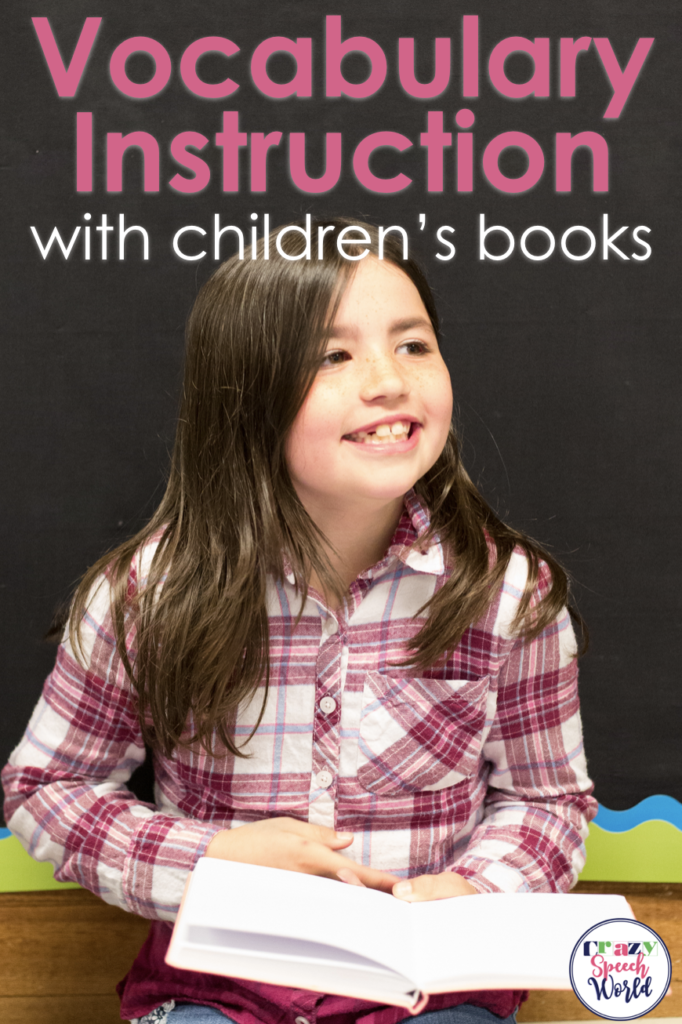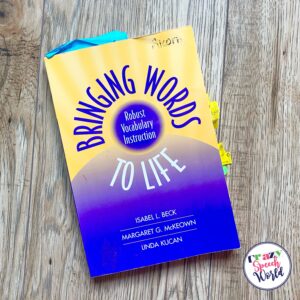I have been involved in some discussions with other SLPs about one of my favorite topics…vocabulary instruction. A few years ago I got to go to this awesome workshop where we focused on the connection between language and reading, and how quality vocabulary instruction is SO important. Not just for our kids, but all kids. At this conference, I was given Bringing Words to Life by Beck, McKeown, & Kucan, and totally changed the game for me… I was given the first edition, but there is now a second edition available and I have that one too! The newer edition includes information related to RtI, Common Core, and writing.
Why do I love this book so much?
It has PRACTICAL information regarding how to provide really good instruction for vocabulary. It explains Tier 1, Tier 2, and Tier 3 words which are classifications for all words. Super Duper has a great handout that outlines these words more specifically, you can download it HERE. At the very basic level, Tier 1 are simple words, such as ball or hand, and Tier 3 words are very specific to a subject, such as tundra or chlorine. Tier 2 words are where we need to focus to make the most impact. These are the words that are used across subject areas, have a high frequency of occurrence, but are still rich in meaning.
The book actually walks you through lessons at various grade levels on how to best choose words, define them, and engage students in activities to further explore the words. Best part? It is research based….HELLO EBP! You can easily use this in therapy, classrooms, or for RtI interventions.
So how has this changed my instruction?
I have been able to incorporate these strategies during therapy in shared book activities with my students. But I have also been able to use these strategies to change vocabulary instruction in the general education classroom!
The way that our school taught vocabulary was by using the words in the reading series that were chosen for them in the teacher manuals. The problem that we had was that many of the words chosen by the reading series we use as ‘vocabulary’ to use were not Tier 2, and the definitions were not student-friendly. They were not words that were really going to make an impact on students’ word knowledge. So I sat down with one teacher and we discussed this and what needed to change. Luckily, this teacher was seeing the same issues I did and had the same vision for change. We went through each story in the reading series and chose new words. Tier 2 words. Words that would build all students’ lexicons. We wrote child-friendly definitions to go with them. Instruction & testing was revamped. The results were phenomenal. The kids were learning the words, using the words in conversations, and building their vocabulary. I can even throw on my mom hat here, cause my son just happened to be in this grade level and he was using the words in our conversations at home. It was SO incredibly exciting and rewarding to watch this happen. The next year, we branched out to another grade level. I wasn’t as involved last year, but I know that these strategies continue to be incorporated…even if it is just in some classrooms. I feel good about that.
I really think this book is a must read, for both SLPs and teachers…anyone who is teaching. If you don’t have it, get it. If it is just sitting on a shelf, dust it off and give it a go. My copy is covered in sticky notes and highlighters.
Have you read this book? What do you think about this approach to instruction?
Disclaimer: This post contains Amazon affiliate links.






![Using open ended activities and games in speech therapy can make planning sessions so much easier! Here are a few suggestions that worked well for me. Do you remember the first time you were faced with a mixed group and were realllllllllly unsure about what to do? I do… picture it, St. Augustine 2007 😅 I was […]](https://i.pinimg.com/236x/db/72/cf/db72cf1f6f5da00cb2a13a90872871ea.jpg)
![Using open ended activities and games in speech therapy can make planning sessions so much easier! Here are a few suggestions that worked well for me. Do you remember the first time you were faced with a mixed group and were realllllllllly unsure about what to do? I do… picture it, St. Augustine 2007 😅 I was […]](https://i.pinimg.com/236x/ae/c5/56/aec55688010e2d3489baf744dde59582.jpg)
![Using open ended activities and games in speech therapy can make planning sessions so much easier! Here are a few suggestions that worked well for me. Do you remember the first time you were faced with a mixed group and were realllllllllly unsure about what to do? I do… picture it, St. Augustine 2007 😅 I was […]](https://i.pinimg.com/236x/18/b9/e8/18b9e80227dfe1789e20a21629254f79.jpg)
![Using open ended activities and games in speech therapy can make planning sessions so much easier! Here are a few suggestions that worked well for me. Do you remember the first time you were faced with a mixed group and were realllllllllly unsure about what to do? I do… picture it, St. Augustine 2007 😅 I was […]](https://i.pinimg.com/236x/4d/34/85/4d3485a753178d000223a89b09162317.jpg)
![Using open ended activities and games in speech therapy can make planning sessions so much easier! Here are a few suggestions that worked well for me. Do you remember the first time you were faced with a mixed group and were realllllllllly unsure about what to do? I do… picture it, St. Augustine 2007 😅 I was […]](https://i.pinimg.com/236x/da/7b/c1/da7bc16b9530451d989a578236bc2bff.jpg)
![Using open ended activities and games in speech therapy can make planning sessions so much easier! Here are a few suggestions that worked well for me. Do you remember the first time you were faced with a mixed group and were realllllllllly unsure about what to do? I do… picture it, St. Augustine 2007 😅 I was […]](https://i.pinimg.com/236x/e0/21/a4/e021a465474b16201d23d0a77857935b.jpg)
![Using open ended activities and games in speech therapy can make planning sessions so much easier! Here are a few suggestions that worked well for me. Do you remember the first time you were faced with a mixed group and were realllllllllly unsure about what to do? I do… picture it, St. Augustine 2007 😅 I was […]](https://i.pinimg.com/236x/fa/94/be/fa94be15b6f184b64e2e408bc762a7e8.jpg)

Looks awesome!!! I’m tempted to grab the older version for less than $5…. (used on Amazon). Do you think it’s worth the extra $20 for the 2nd version???
The older version has all of the basic information on how to use these strategies. I haven’t been using the new one (just ordered it a few days ago) and have been successful. The new one says it includes info on RtI and writing, which are areas I am interested in reading about. But I think you would fine with the older one, if you just want to learn about the strategies!
Just ordered it! I’m a student SLP and have a clinical pLacement in a school coming up soon so I hope it arrives before then, but IT looks interesting and useful for the future anyway. Yay for EBP! I will pass it on to my teacher friends/family too. Thanks for sharing!
Awesome!!! You can definitely wow your supervisor with using the lessons from it 🙂 You’re welcome!
Thanks for sharing this resource! I have been convinced for a long time that teaching vocabulary is one of the best ways to help our students improve overall language skills. But the problem is, what vocab to teach? I’ve looked EVERYWHERE for a resource that says what vocab words are best for each grade. Haven’t found anything. I’m excited to read this resource!
Aersta
thespeechclinic.wordpress.com
You’re welcome! This is exactly why I did this post…people NEED this is their therapy room!
I have the 1st edition as well as the other Beck book…Creating Robust Vocabulary: Frequently Asked Questions and Extended Examples. They are great. I used these for my Master’s research project and paper for my Administrative Licensure.
I am also an SLP working on an administrative degree, with vocabulary as the focus for my project. Thanks for the tip on the other Beck book as well!
I purchased book along with Creating Robust Vocabulary too. I have tried to use them in my therapy sessions. They are both awesome!
I read “Bringing words to Life” a couple years ago….It has so many amazing examples and ideas for effectively teaching vocabulary instruction! Where was this book when I was in grad school 20 years ago!! It seems to be all the buzz lately on the blogs summer reading lists! I may just have to use it as reference in a future blog post (and add a link to your post if you don’t mind) It’s nice to know I was using some of these techniques already without realizing they were in this book. I also like to use the strategies with my 10 year old son to help him build his vocabulary. Great stuff!!! Rose (“speechsnacks”)
I read this some years ago and count it as a consultation coup! After hearing about it from a fellow SLP, I handed it off to our literacy specialist and before I knew it, she had started a school-wide initiative and teachers were asking me to help them with “kid friendly definitions” for their units. I no longer felt solely responsible for addressing my student’s vocabulary deficits, which I don’t believe an SLP can do in a 2×30 service delivery model anyway- Beck supports this by promoting frequent opportunities to encounter each vocabulary word. Instead I could develop vocab through consultation, thanks to Beck.
Did you know there were some commercial products developed from this- make it easier to implement? Steck-Vaughn’s Elements of Reading-Vocab and Scholastic’s Text Talk.
Dr. Bonnie Singer just told me about this free curriculum from Harvard as well:
http://wg.serpmedia.org
I totally agree, it can’t just be our responsibility! I think that is part of what makes this book great, that teachers can take these strategies and implement them easily in their classroom.
I knew about Text Talk, but not the others..thanks Sean!
You hit the nail on the head! Vocabulary deficits cannot be remediated in our little world alone. Thanks for sharing your resources!
Have you ever read or used “Creating Robust Vocabulary”? It is by the same authors. One thing I always work on is vocabulary through themes but I have not had any specific guidance on what vocabulary is most important. I am looking for something to help me in this area. I was just curious if you would recommend this book versus the other (if you have read it). What are your thoughts?
comment by Brittany Messerlie